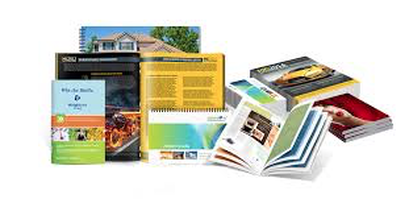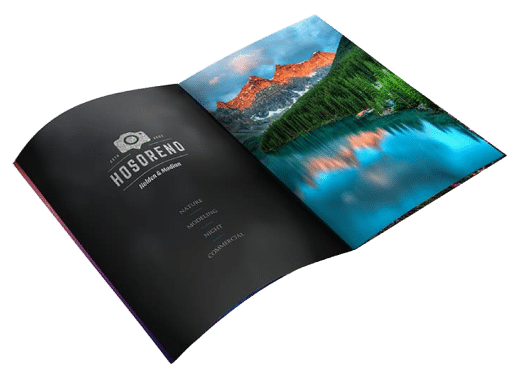The Vital Overview to Comprehending Booklet Printing Options and Techniques
The procedure of brochure printing involves multiple factors to consider that can significantly influence the last item. From selecting the proper style and dimension to understanding the subtleties of binding techniques, each option plays an important role. Additionally, variables such as paper supply and printing techniques more affect the efficiency of the brochure. As one navigates these alternatives, it becomes important to comprehend just how they interconnect and what that means for the overall result.
Recognizing Booklet Layouts and Dimensions
When thinking about brochure printing, comprehending the various styles and sizes available is crucial for attaining the preferred discussion. Brochures can be created in countless formats, including saddle-stitched, spiral-bound, and perfect-bound, each offering distinctive benefits. Usual sizes vary from common letter (8.5 x 11 inches) to smaller alternatives like A5 (5.8 x 8.3 inches), allowing for flexibility based upon web content and target audience.Selecting the proper size can influence both the format and reader engagement. Bigger sizes may fit aesthetically driven material, while smaller styles might be extra straightforward and portable. In addition, the number of pages influences the choice of binding technique, as thicker booklets might need stronger bindings. Inevitably, recognizing these facets enables a more tailored method, guaranteeing that the final product lines up with the intended message and aesthetic, improving the general effectiveness of the communication.
Picking the Right Paper Stock

Binding Approaches: Factors To Consider and choices
When it pertains to binding techniques for booklets, several choices are available, each with unique benefits. Saddle stitch binding offers a cost-effective service for thinner booklets, while ideal binding strategies supply an even more sleek look for thicker publications. Wire-O binding stands apart for its toughness and convenience of use, making it optimal for documents that require flexibility.
Saddle Stitch Binding
Saddle stitch binding supplies a practical and cost-effective solution for putting together booklets, making it a popular choice amongst services and publishers. This binding method involves folding sheets of paper in half and stapling them along the fold line, producing a cool and orderly look. Generally suitable for brochures with a lower page matter, saddle stitching is perfect for magazines, pamphlets, and training products. The simplicity of this technique permits for fast production and is commonly preferred for marketing things or short runs. It is essential to keep in mind that saddle stitch binding may not be suitable for thicker booklets, as the back might not hold up under boosted weight. In general, it remains a dependable option for several printing jobs.
Perfect Binding Techniques
Perfect binding is a commonly used method that offers a professional and polished finish to publications and pamphlets. This approach entails gluing the web pages together at the spine using a solid adhesive, enabling for a clean side and the capability to hold a bigger variety of pages contrasted to saddle stitching. Perfect binding is especially ideal for thicker pamphlets, such as directories and annual records, where a durable, level spine is desired. Additionally, it uses the option for a published cover that can be made to improve visual charm. Factors to consider such as page matter, paper weight, and the intended use of the pamphlet ought to be taken into account, as they can affect longevity and overall quality.
Wire-O Binding Options
Wire-O binding, known for its longevity and adaptability, provides an exceptional option for pamphlets that need simple web page transforming and an expert look. This binding approach utilizes a collection of steel loopholes that hold pages safely, enabling them to exist level when open. It is especially appropriate for handbooks, discussions, and magazines as a result of its robust nature. Wire-O binding is available in different colors and diameters, fitting various page counts and thicknesses. In addition, it permits the addition of tabs and covers, enhancing the brochure's general aesthetic. Considerations for Wire-O binding include the option of cord color, the dimension of the loops, and the extent of customization desired, all of which can exceptionally affect the end product's look and functionality.
Digital vs. Offset Printing: Which Is Best for You?
When selecting a printing technique for booklets, comprehending the distinctions between digital and offset printing is vital. Digital printing uses contemporary technology to produce high-quality prints swiftly and economically, making it optimal for brief runs or jobs calling for fast turn-around times. It enables for customization, supplying the capability to print on-demand with marginal waste.In contrast, balance out printing is a traditional approach that stands out in generating large quantities with consistent quality. It entails moving ink from a plate to a rubber covering, after that to the paper, which results in exact information and dynamic shades. Counter printing typically calls for longer arrangement times and is a lot more cost-efficient for larger volumes.Ultimately, the selection between electronic and counter printing depends on project needs, budget, and desired amount. For little, time-sensitive projects, electronic may be the very best choice, while countered might be more effective for larger, top quality productions.

Designing Your Brochure: Tips and Best Practices
When making a pamphlet, careful interest to design, font selection, and color use can substantially improve its efficiency. A well-structured design guides the reader's eye, while ideal fonts guarantee readability and share the wanted tone. Furthermore, effective use color can evoke emotions and emphasize crucial details, making the general design much more impactful.
Selecting the Right Format
Exactly how can one properly select the appropriate layout for a booklet? Initially, it is important to examine the pamphlet's purpose and target audience. A clean, arranged format enhances readability and interaction. Making use of a grid system can aid in straightening components constantly, developing an expert look. In addition, incorporating aesthetic power structure with differing dimensions and positionings of photos and message can direct the visitor's eye and highlight key information. It is also vital to leave adequate white area, which prevents congestion and permits better emphasis. Finally, testing different layouts through mock-ups can supply insight into just how the layout performs in real-world circumstances, ensuring that the end product look here fulfills both useful and visual needs.
Selecting Suitable Typefaces
A well-chosen font can significantly improve the general style of a brochure, complementing the layout and reinforcing the content's message. The selection of fonts ought to take into consideration readability, especially for body message, as it assures the details is accessible to all viewers. Sans-serif typefaces are typically liked for electronic layouts, while serif typefaces can lend a traditional feel in published materials. It's recommended to restrict font selections to two or three to keep visual comprehensibility. Additionally, font size plays an important role; headings must be not frustrating however unique, while body text need to fit for reading. When picking font styles, positioning with the booklet's motif and target market is vital for effective interaction and aesthetic allure.
Efficient Use Shade
Color acts as a powerful device in brochure layout, shaping perceptions and leading visitor feelings. It can evoke sensations of peace, count on, or enjoyment, depending on the shades picked. Developers ought to consider color concept principles, making sure that the selected scheme aligns with the brochure's message and target market. Using warm colors like red and orange can develop urgency, while cooler tones like blue and eco-friendly foster tranquility.Additionally, comparison plays an essential duty; corresponding shades can enhance readability and aesthetic allure. Uniformity in shade usage across pages even more enhances brand identity and cohesion. Eventually, efficient shade application not only catches interest but likewise strengthens the pamphlet's objective, making it an important aspect of successful style.
Completing Touches: Coatings and Special Effects
While many consider the web content and design of a booklet the most critical elements, the ending up touches, such as layers and unique impacts, play a necessary you can look here function in enhancing its overall allure. Coatings can supply security and resilience, guaranteeing that the booklet holds up against damage. Matte surfaces offer a sophisticated, non-reflective surface area, while shiny coatings can make colors appear even more appealing and vibrant. Unique effects, like embossing or aluminum foil stamping, add a tactile measurement that can create a remarkable perception. These techniques can highlight details areas, accentuating crucial information or developing visual rate of interest. Additionally, UV coating can supply a high-shine finish that raises the overall look.Together, these completing touches not only boost the brochure's visual but additionally communicate expertise and focus to detail, inevitably leaving a long lasting influence on the reader.
Expense Factors To Consider for Pamphlet Printing
Understanding the different price considerations for brochure printing is crucial for companies and organizations aiming to enhance their spending plans. Key aspects influencing prices consist of the choice of binding, Full Report paper, and ink methods. Higher high quality materials, such as superior paper or specialized inks, typically increase the general cost. In addition, the dimension and page count of the brochure play a substantial duty; bigger pamphlets require more sources and time to produce.Another essential consideration is the printing technique, whether digital or balanced out, as each has its own prices structure and suitability for different quantities. Businesses ought to also factor in design costs, which can vary based on intricacy and using specialist solutions. Ultimately, shipping and handling fees can contribute to the total, especially for large orders. By reviewing these elements, organizations can make educated choices that line up with their monetary capacities while attaining the preferred high quality in their published products.
Regularly Asked Concerns
What Are the Environmental Impacts of Brochure Printing?
The environmental impacts of brochure printing include deforestation from paper manufacturing, carbon exhausts from transportation, and waste generation from discarded materials - Booklet Printing. Sustainable techniques, such as utilizing recycled paper and environment-friendly inks, can alleviate these effects
Just How Can I Make Certain Shade Accuracy in My Booklet?
To assure color precision in a brochure, one ought to utilize adjusted screens, employ specialist color accounts, perform test prints, and select high-quality printing solutions that provide shade matching and proofing choices for ideal outcomes.
What Is the Common Turn-around Time for Brochure Printing?
The typical turn-around time for booklet printing differs depending on the intricacy and quantity - Booklet Printing. Usually, it ranges from a couple of days to two weeks, affected by variables such as printing methods and ending up requirements
Exist Minimum Order Quantities for Booklet Printing?

Can I Print Brochures in Several Languages?
Publishing pamphlets in numerous languages is feasible. Several printing services offer choices for multilingual or multilingual designs, enabling reliable interaction. Careful planning guarantees that develop components accommodate various languages without compromising readability or appearances. Additionally, factors such as paper supply and printing strategies more affect the performance of the pamphlet. When considering booklet printing, understanding the numerous layouts and dimensions offered is necessary for attaining the preferred discussion. When selecting a printing technique for brochures, understanding the differences between digital and counter printing is crucial. In addition, the size and page matter of the brochure play a considerable role; larger pamphlets need more resources and time to produce.Another important factor to consider is the printing method, whether digital or countered, as each has its very own prices structure and suitability for different quantities. The ecological effects of booklet printing consist of deforestation from paper manufacturing, carbon discharges from transportation, and waste generation from thrown out materials.